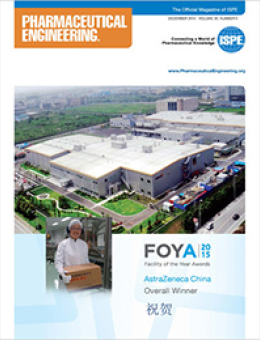
Downloads
A New Sandbox for ISPE and Its Members around the World
Guest Editorial: The ISPE International Board of Directors has undertaken a strategic planning process for the years 2016–2019 and the fi nal strategic plan, now complete, was launched at the 2015 Annual Meeting in Philadelphia.
AstraZeneca China: FOYA Category Winner for Project Execution Takes Top Prize
Cover Story: A highly-integrated and multinational team from China, Sweden, Denmark, the UK and the Americas was built. The team included an AstraZeneca engineering team, engineering and construction management consultants, local trade contractors, equipment suppliers and cross-functional AstraZeneca end-users. From the beginning, the AstraZeneca mantra “One Team, One Goal” was embraced.
The Value of Process Capability
Feature: In July 2015, the US Food and Drug Administration issued its “Draft Guidance for Industry: Request for Quality Metrics. One of the optional metrics proposed in this guidance is a statistical assessment of process capability/performance. In August of the same year a select group of industry thought leaders met in Washington, DC, under ISPE’s auspices to consider the intrinsic value of process capability, monitoring, and control as a quality metric.
GMP or Non-GMP Washers and Sterilizers: How to Choose
This article presents the standards and guidelines typically used by manufacturers to design and build GMP washers and sterilizers. It describes the characteristics that differentiate GMP from regular laboratory equipment.
Biopharmaceutical Research and Manufacturing through the Decades
This article presents how biotechnology, bioprocessing, and biomanufacturing matured and advanced over the last 35 years into a complex and patient-centered industry with record solutions that compete one-to-one and surpass older small-molecule drug substance technology, opening the door to game-changing production efficiencies in biopharmaceutical production and drug delivery.
Reduction of Human Error in Hybrid Facilities with Single-Use Equipment
This article presents a useful guide to help prevent human error in hybrid facilities. It seeks to understand why the industry developed current practices, what human errors are being made, what has changed in the last 5 years and how future factories could operate. Will the new equipment and new approaches lead to safer, more reliable and repeatable factories?
Pharmacovigilance Operational Excellence: A Case Study
This article describes a case study on how the principal elements of operational excellence were put to task by a dynamic, self-directed pharmacovigilance team to better ensure patient safety.